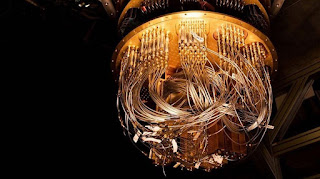Artificial networks learn to smell like the brain
Oct 2021, phys.org
We now have an artificial neural network that works like the nose. It's not an electronic nose; that's not the big deal part.
What's important here is that, first of all, this is from the lab that brought us olfactory receptors. Next, these scientists didn't even model the network on evolution. They made an algorithm to solve an odor categorization task, and let the network run with it. Some might call that artificial evolution, but scientists will call it machine learning. After several iterations, the network found an optimized structure for solving this task -- the network ended up looking just like our olfactory system. Go figure.
The "brains" of a neural network lies in its ability to reduce the dimensionality of the information thereby optimizing computation. This is done using compression layers that learn to accept information from some neurons and not from others. After enough iterations, a pattern emerges between the layers of neurons.
Talking about this pattern, and the number of neurons connected to by each neuron on the compression layer:
"It could have been one, it could have been 50. It could have been anywhere in between," Yang says. "Biology finds six, and our network finds about six as well."
The first part of our nose where the hundreds of olfactory receptors collapse into far less neural nodes, one layer up the network, is very similar to the type of artificial neural network used in this study. It is, apparently now supported by these findings, a very effective way to condense a multi-dimensional information-space of chemical signals. Would it work for other information-spaces? What other Big Data can this deep nose model compute?
The side story: Evolution found this organization through random mutation and natural selection over eons; the artificial network found it through standard machine learning algorithms, in under one minute.
via Massachusetts Institute of Technology: Peter Y. Wang et al, Evolving the olfactory system with machine learning, Neuron (2021). DOI: 10.1016/j.neuron.2021.09.010
Image credit: Google's quantum computer, totally unrelated, just for looks
Post Script:
Neural network reveals new insights into how the brain functions
Dec 2021, phys.org
"The neural network model approach we have developed in this work presents an 'instruction manual' for other researchers to use to study other areas of the brain or other organs"-co-author Dr. James Martin, co-author and professor of molecular physiology and biophysics at Baylor College
Their model is called Spatial Transcriptomics cell-types Assignment using Neural Networks (STANN).
via Baylor College of Medicine: Francisco Jose Grisanti Canozo et al, Cell-type modeling in spatial transcriptomics data elucidates spatially variable colocalization and communication between cell-types in mouse brain, Cell Systems (2021). DOI: 10.1016/j.cels.2021.09.004
I'm not certain about this, but I think the reason they chose the olfactory system is because they were looking at the interaction of transcription genes and brain cell types, and the olfactory receptor brain cells are the only one's that each get their own gene. So that would make the olfactory bulb an ideal nexus for investigation of this kind. See studies below for further reference:
Marei H.E.S. et. al. Gene expression profile of adult human olfactory bulb and embryonic neural stem cell suggests distinct signaling pathways and epigenetic control. PLoS One. 2012; 7: e33542. https://doi.org/10.1371/journal.pone.0033542
Nagayama S. et. al. Neuronal organization of olfactory bulb circuits. Front. Neural Circuits. 2014; 8: 98. https://pubmed.ncbi.nlm.nih.gov/25232305/

No comments:
Post a Comment